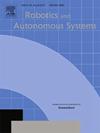The Soft-PVTOL: Modeling and control
IF 4.3
2区 计算机科学
Q1 AUTOMATION & CONTROL SYSTEMS
引用次数: 0
Abstract
This paper introduces, for the first time, the soft planar vertical take-off and landing (Soft-PVTOL) aircraft. Unlike conventional PVTOL and multi-rotor systems, where position alterations inevitably impact orientation due to their underactuated design, the Soft-PVTOL offers the unique advantage of decoupling these dynamics, enabling unprecedented maneuverability and precision. We have demonstrated that the Soft-PVTOL can be accurately modeled using the Euler–Lagrange framework under a constant curvature assumption for the soft arms. This approach provides a significant advantage for designing control strategies tailored explicitly for soft aerial robots, offering a concise and singularity-free mathematical model that accurately captures the system’s dynamics. Furthermore, the model’s flexibility supports extensions to multiple constant curvature segments per arm, allowing scalability to more complex configurations and further broadening its applicability to the field of soft aerial robotics. Having demonstrated that the Soft-PVTOL satisfies the passivity property under our model, we designed a passivity-based control law to ensure global exponential convergence of the tracking error. Numerical simulations, including perturbations affecting the system, validate the robustness of the proposed approach, demonstrating effective trajectory tracking and decoupled position-orientation control, even under adverse conditions. These results demonstrate the Soft-PVTOL’s adaptability and maneuverability, marking a significant advancement in aerial robotics and establishing a foundation for future research into more sophisticated and versatile soft aerial robot designs.
软pvtol:建模和控制
本文首次介绍了柔性平面垂直起降(soft - pvtol)飞机。与传统的PVTOL和多旋翼系统不同,由于其驱动不足的设计,位置变化不可避免地会影响方向,软PVTOL提供了解耦这些动力学的独特优势,实现了前所未有的机动性和精度。我们已经证明,在软臂的恒定曲率假设下,使用欧拉-拉格朗日框架可以准确地建模软pvtol。这种方法为设计针对软空中机器人量身定制的控制策略提供了显著的优势,提供了一个简洁且无奇点的数学模型,可以准确地捕捉系统的动态。此外,该模型的灵活性支持扩展到每个手臂的多个恒定曲率段,允许可扩展性到更复杂的配置,并进一步扩大其在软航空机器人领域的适用性。在证明了该模型的无源性的基础上,设计了基于无源性的控制律,以保证跟踪误差的全局指数收敛。数值模拟,包括影响系统的扰动,验证了所提出方法的鲁棒性,证明了即使在不利条件下也能有效地跟踪轨迹和解耦位置-方向控制。这些结果证明了软pvtol的适应性和可操作性,标志着航空机器人技术的重大进步,并为未来研究更复杂和通用的软空中机器人设计奠定了基础。
本文章由计算机程序翻译,如有差异,请以英文原文为准。
求助全文
约1分钟内获得全文
求助全文
来源期刊

Robotics and Autonomous Systems
工程技术-机器人学
CiteScore
9.00
自引率
7.00%
发文量
164
审稿时长
4.5 months
期刊介绍:
Robotics and Autonomous Systems will carry articles describing fundamental developments in the field of robotics, with special emphasis on autonomous systems. An important goal of this journal is to extend the state of the art in both symbolic and sensory based robot control and learning in the context of autonomous systems.
Robotics and Autonomous Systems will carry articles on the theoretical, computational and experimental aspects of autonomous systems, or modules of such systems.
 求助内容:
求助内容: 应助结果提醒方式:
应助结果提醒方式:


